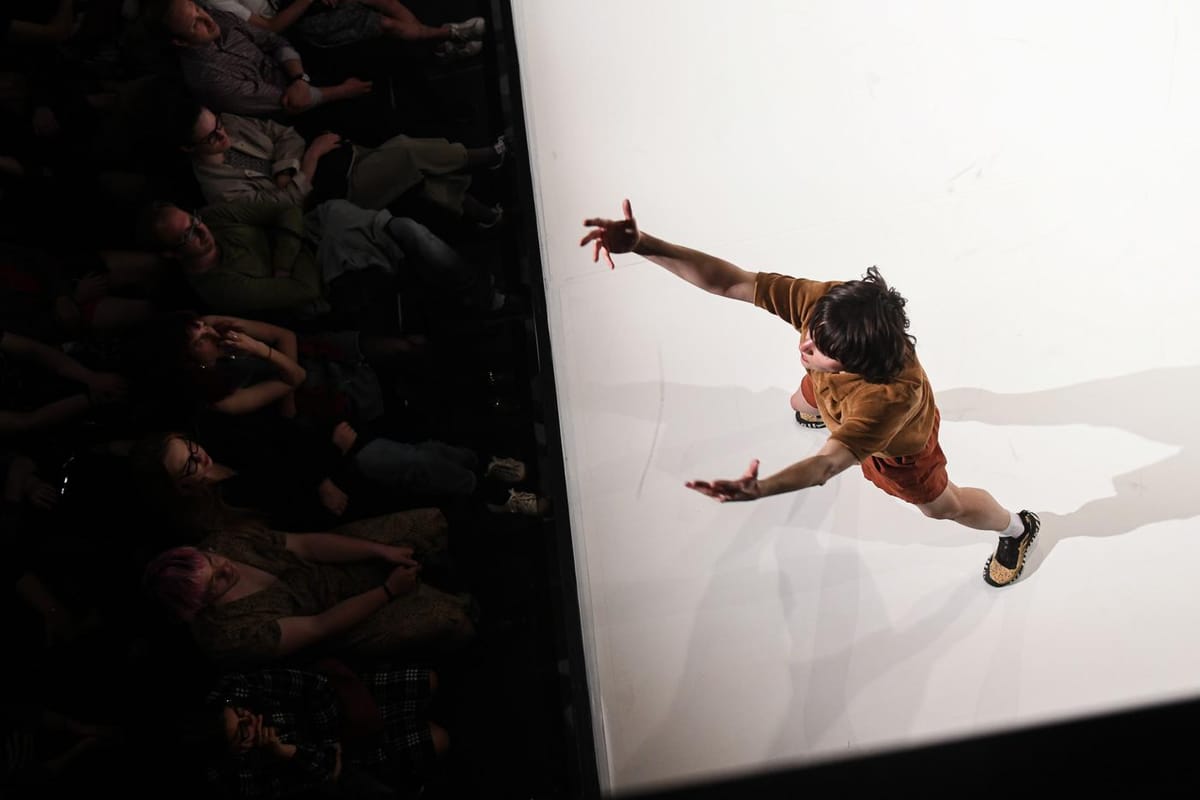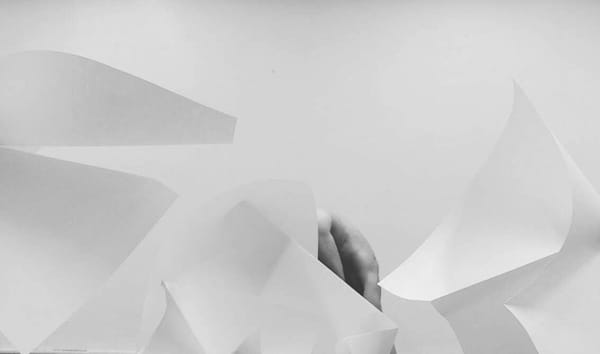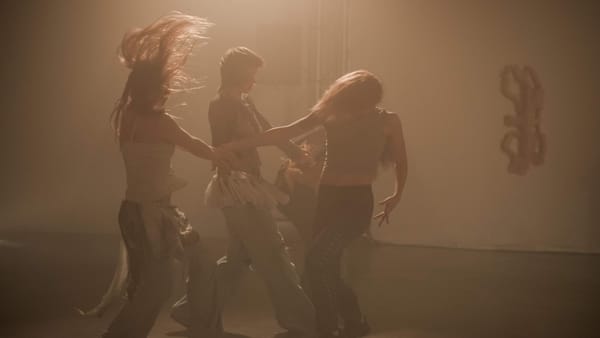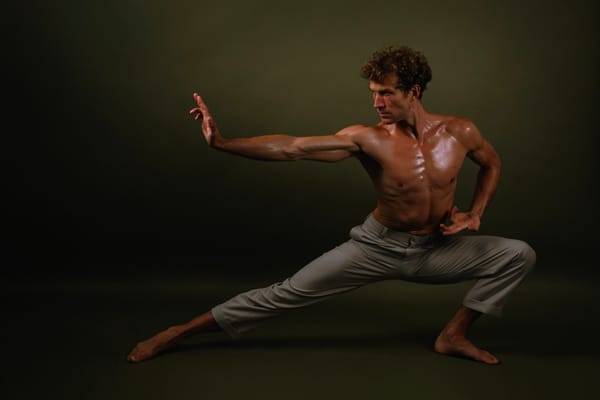Bodies of Evidence: Sasha Portyannikova's Political Dance
In a country where protest is a crime, the dancing body itself becomes a site of resistance. Choreographer and researcher Sasha Portyannikova documents how artists under impossible conditions continue to create despite all risks.

"It so happened that I was born in a country that no longer exists," writes Sasha Portyannikova in her contribution to the Structure issue of A Dance Mag. "It so happened that I dreamed the country that issued my current passport would inherit the fate of the one I was born in."
Writing from her current base in Innsbruck, Austria, Sasha has just returned from a winter 2023-24 visit to Russia—her first since the war began. In "Minor Urgent Dance in Mordor," she documents what she found: a dance scene surviving against impossible odds, military recruiters at train stations, and a contemporary dance collective in St. Petersburg scraping together rent money while risking repercussions for criticizing the war.
A Witness Shaped by History
This isn't Sasha's first time documenting Russian dance stories that others would prefer to forget. For nearly a decade, she's worked with Daria Plokhova to hunt down their predecessors, uncovering lost avant-garde dance experiments from early Soviet history that had been buried under decades of state-sanctioned movement.
Soviet Gesture started in 2015 as a hunch and grew into a five-year investigation. Sasha and Daria worked to uncover 1920s radical dance and movement practices that emerged in parallel with similar movements in Western avant-garde dance.
They found evidence of movement laboratories where Soviet artists explored movement as a complex intersectional practice, creating collaborative scores, developing movement and notation systems. These weren't the propaganda ballets history remembers, but practices that treated the dancing body as a space of creative freedom.
The investigation culminated in The Manual for the Practical Use of a Dance Archive (2020), published by Moscow's Garage Museum of Contemporary Art. From the manual, Sasha and Daria created a multimedia performance-lecture that brought forgotten movements back to life, demonstrating how to excavate dance history through bodies themselves.
When Personal Becomes Methodology
A Fulbright Scholar who taught at The New School in New York in 2018, Sasha has navigated between Russian and Western dance worlds. Having lived and worked across Russia, the U.S., and Europe, she reflects that "the structure of those landscapes became clearer for me in both their specifics and similarities." She identifies three dance ecosystems present in every landscape she encounters: "institutionalized dances" like ballet and musical theater; "popular and social dances" with their own power dynamics; and "experimental scenes," which she says are challenged by "both political correctness and the realities to which university campuses do not prepare the students for."
Her recent solo work parsley for garnish (2024) addresses this tension. The piece reimagines Petrushka, the Russian puppet figure, to explore what it means to be a post-Soviet dance artist in Western Europe. Through an onstage question-card game, she forces audiences to confront their assumptions about migration.
For Sasha, games serve a specific purpose: "I view games as a form of distraction from self-censorship. An opportunity to simulate certain situations/experiences. It also allows for observing the behavioral strategies. I like that it creates the distance between the playfulness of the process and the reflection on the content that can happen later. Or not."
This questioning approach runs through her curatorial work on Touching/Moving Margins, her ongoing project with Nitsan Margaliot and Anna Chwialkovska to document underrepresented dance histories. The project has shifted her perspective: "The colonial heritage became literally palpable for me through the Touching/Moving Margins project. The violence of the universalist approach no longer seems to me a metaphor or exaggeration."
She continues: "Consequently, I remain lost in my worldview paradigm because I grew up in a paradigm that regarded progress as an unquestionable benefit for humanity. I still see that there are benefits, but I also start to discover at what costs. I also see that they are still not uniformly distributed, and sometimes lose the belief that they ever would."
Whether she's creating a performance or profiling underground dance studios, she's consistently asking who gets remembered and who gets forgotten in dance history.
Teaching as Investigation
Sasha's work extends into her teaching practice across Europe and beyond. Her labs invite participants to discover how dance can function as a form of research—how moving bodies can uncover historical elements that written records miss. Students might spend a session reconstructing a lost Soviet movement score, then use that experience to question how their own cultural backgrounds shape their dancing.
This pedagogical method reflects her belief that dance education should cultivate critical thinking about how bodies move through history, politics, and culture—skills that prove essential whether you're uncovering 1920s Soviet experiments or documenting contemporary artists working under political repression.
The Urgency of Now
But Sasha expresses concern about what she sees across experimental dance scenes: "I notice that in each of the places, experimental scenes struggle with the process of dance disappearance. The connection to cutting-edge humanitarian ideas, which fostered their development throughout the 20th century, entrapped them within a conceptual frame that substitutes embodied implementation and craft with text and concept. I feel like we are drifting away from dance to text, and it bothers me."
At a time when dance histories remain dominated by Western canonical narratives, Sasha's work demonstrates a methodology for approaching forgotten movement practices anywhere, showing what becomes possible when someone commits to unraveling the stories that institutional dance history has overlooked.
Through her performances, research, and urgent contemporary documentation, she shows that dance history isn't just about preserving the past—it's about understanding how dance can challenge power structures, create communities, and imagine possibilities for survival. Her work suggests that every dance practice contains both visible canons and buried alternatives, and that excavating these alternatives might be essential for understanding what dance can really do.
As she puts it: "Dance is a cultural, social and political practice." In Sasha's hands, whether she's bringing forgotten Soviet experiments back to life or documenting how contemporary Russian artists navigate an impossible present, it functions as a tool for investigation, resistance, and witness.
Find more about Sasha here: https://www.sashaportyannikova.com





